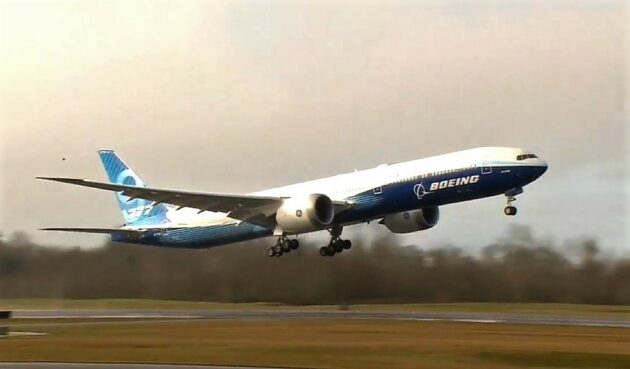
Boeing’s 777X takes off on its first flight Saturday morning. (Screenshot via Boeing Webcast)
EVERETT, Wash. — After a one-day postponement due to bedeviling winds, Boeing’s next-generation 777X wide-body jet took off for its first flight today, providing a boost to the embattled company amid the crisis over its narrow-body 737 MAX.
“This airplane, for me, is the flagship of the big airlines around the world,” Wendy Sowers, director of marketing for the 777X, told reporters in advance of the flight. “It’s really the marquee airplane.”
The 777X represents a major update for the Boeing 777, which has essentially taken over the title from the 747 as the biggest passenger airplane that Boeing makes. The “Dash 9” model, which is having its first flight test today, boosts the typical maximum seating capacity from the 777’s 365 to 425. Thanks largely to its twin GE9X engines, it improves the 777’s per-seat fuel efficiency by about 13 percent, Boeing says.
The plane’s 235-foot-wide wings are the longest that Boeing’s ever built, and they’re made of cutting-edge carbon composite. The wings are so wide that they have to be built with hinged tips that are raised when the plane pulls into a standard airport parking spot.
Boeing also adapted technological advances from its slightly smaller 787 Dreamliner, which entered the market in 2011 after the introduction of the 777. Those advances range from the look of the flight deck to the size and workings of the passenger cabin’s windows.
This first flight comes after years of development, and marks the first off-the-ground step toward certifying the plane for operations. Sowers said Boeing will be applying the lessons learned from the issues that came up after two catastrophic crashes force the worldwide grounding of the 737 MAX fleet.
If all goes well, the first 777X deliveries will be made in 2021. But all doesn’t necessarily go well, as illustrated by the one-day delay in the first flight.
Thousands of Boeing workers and VIPs turned out on Friday here at the company’s wide-body jet assembly plant in Everett to watch the takeoff, only to walk away frustrated more than three hours later.
Even though it was rainy and breezy, the 777X rolled out majestically and took its position at the south end of the Paine Field runway, waiting for the weather to settle down. It never did.
Boeing officials said winds from the south had to drop below 10 knots (11.5 mph) before the final go-ahead was given. The situation was complicated by the fact that the plane had to take off to the north and fly over water rather than populated areas, as a safety precaution. A tailwind blowing to the north could have reduced the 777X’s lift too much to be safe for a first takeoff.
While the 777X’s test pilots waited, a succession of planes, including Alaska Airlines passenger jets and Boeing’s mammoth Dreamliner transport plane, landed from the north and took off to the south — taking advantage of the same winds that were keeping the new plane on the ground.
The winds stayed in the range of 13 to 18 knots, at times gusting in the range of 30 knots. At 1:30 p.m., three and a half hours after the appointed takeoff time, Boeing called off the attempt and rescheduled for today.
This time around, the winds were below the 10-knot limit for takeoff.
Now that the 777X is finally in the air for the first time, Boeing’s flight crew is expected to put the plane through its paces over the course of a couple of hours, and then bring it in for a landing and a post-flight recap at Boeing’s Seattle Delivery Center this afternoon.
Check back for updates in this developing story.
